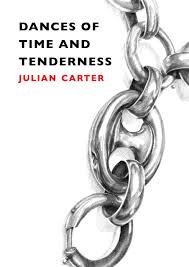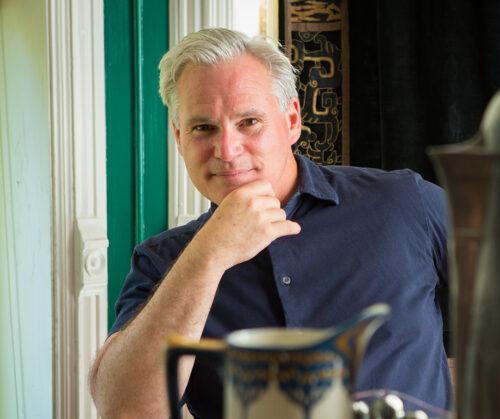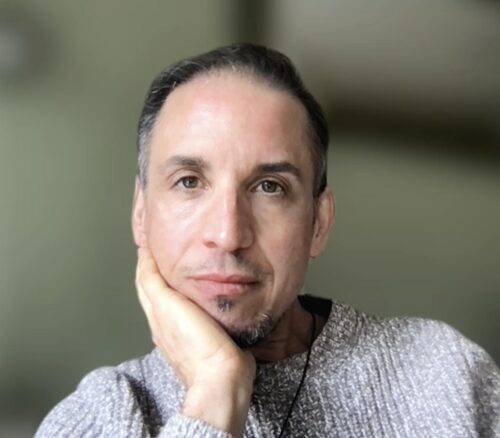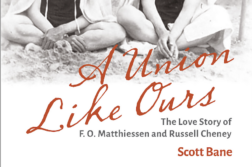 The following is a condensed conversation between Julian Carter and Jonathan David Katz about Carter’s new book, Dances of Time and Tenderness (available now from Nightboat Books), a cycle of “transpoetic” stories that take us from the dungeons of 1990s San Francisco to the goldsmith’s forges of the earliest cities. In what follows, Carter and Katz discuss desire, physicality, and radical politics as touchstones to queer memory, exploring the “porosity” of the human body and its implications for social and sexual interaction.
The following is a condensed conversation between Julian Carter and Jonathan David Katz about Carter’s new book, Dances of Time and Tenderness (available now from Nightboat Books), a cycle of “transpoetic” stories that take us from the dungeons of 1990s San Francisco to the goldsmith’s forges of the earliest cities. In what follows, Carter and Katz discuss desire, physicality, and radical politics as touchstones to queer memory, exploring the “porosity” of the human body and its implications for social and sexual interaction.
Jonathan David Katz: You offer compelling descriptions of bodies as profoundly porous, in some instances quite literally, as when you remind us that the surfaces of our skins are permeable and our basic biochemistry works by molecular movement across membranes and cell walls. What drew you to writing about the permeability of the body?
Julian Carter: Somatic experience! I feel [as if]the boundaries and densities of my body are in constant change.
JDK: You start with your sense of bodily self-presence, and you tell your stories in first person. You also emphasize that Dances of Time and Tenderness isn’t a memoir. Can you talk about that?
JC: Writing in first person serves as an anchor point for sweeping claims I can’t substantiate any other way. I do tell stories based in real events, and I’m using a version of my own voice rather than developing a fictional character, but deploying first person doesn’t mean that all my stories are true. In different chapters I say explicitly that this is not a memoir but a theory of history, a lab report, a fairy tale, a call to arms. I also warn readers that I’m an unreliable narrator. The point isn’t for you get to know me. It’s more that first person is intimate. I use it to evoke (and invoke) the experience of connectedness, body- to- body and across time. What I and many others have found from such encounters is that touch is expansive. It ranges in scale and density from the most minute electron transfer up to cities, always returning to ordinary human-scaled activities of respiration, circulation, and imagination. This idea shows up again and again in trans and queer studies, performance studies, feminist theory, cultural historiography, affect theory, and science studies, as well as in poetry and contemporary cross-genre experimental literary forms.
JDK: Right. I’m interested in the way you use images of porosity to make the auto-theoretical claim that we gather our sexual and political identities from other people’s lives. Where and how are identity and identification different from identity appropriation? What does this difference have to do with how firm & how durable we imagine the body’s borders to be?
JC: Well, that’s why we need devices to contain and separate ourselves from ourselves, objects, and others: voltage-gated ion channels, sphincters, stop signs. The porousness of bodies doesn’t mean that we all blur together into a mass of shared sense and social experience. We don’t move in the world as one. That’s where the essentially political question of appropriation comes in. Sometimes they want to establish a worldview as absolute and opaque, insisting they can only be understood by people whose social experience maps closely on their own. I worry that they are weaponizing self-identity in a way that lets them off the hook of risking potentially transformative contact with genuine difference. If there’s anything I learned from the butch/femme culture of the bars where I came out in 1980s Georgia, it’s that honoring difference doesn’t mean holding ourselves apart from it. Contact between unlike substances can generate friction, light, and heat. Risk is built in–we don’t necessarily get to control the outcomes.
Sex is one obvious arena for encountering that kind of risk. Art is another, especially art that exaggerates and dramatizes the tension between the artist’s agency and the viewer’s independence. The performers I write about—Julie Tolentino, Xandra Ibarra, the late William Pope.L—open themselves to the imagination of the other, inviting us to enter this unique mode of consciousness where the artist’s offering and the audience’s receiving mingle. Their work demands that we enter an experience of time and presence that didn’t originate in our own body/minds, sometimes to slip into a zone where coherent selves are irrelevant (let alone identity boundaries) and at other times to collide with the incommensurate. Nobody can own, or claim, that space of consciousness. You can’t appropriate what can’t be owned. This is, in fact, a fundamental part of contemporary indigenous-led movement against corporate attempts to patent traditional knowledges and substances.
JDK: I’m reminded of the chapter where you recall the 1980s lesbian-feminist insistence that only women can represent women’s historical experience. Should we (still, again) be asking the question of whether any given historical account—say, of “passing women”—properly “belongs” to trans or queer people?
JC: Left to myself in the world of history and imagination, I don’t see the point of even trying to hold “queer” and “trans” [as]separate. One reason is that I move through the world as a gendered scintillation akin to early twentieth century fairies and to contemporary nonbinary people; I’m queer as the winter nights are long, and I’m part of a tradition in which my effeminacy is as much as a function and expression of my queerness as of my transsexuality.
JDK: These stories are embedded in San Francisco’s unique hothouse of hybrid identities and practices. How might we extend the seductive political vision you spin to other parts of the country?
JC: Well, I did come out in Georgia. Somewhere I came across the claim that the South has the highest concentration of “LGBTQ” people of any region in the U.S. All those people aren’t creating selves and communities out of some platonic ideal of “queer” and they aren’t modeling themselves on the urban enclaves of the coasts. They have their own political visions! Even those who left carried their formative years with them, and not always ambivalently. Lou Sullivan was from Milwaukee; Susan Stryker’s from the same undistinguished part of Oklahoma my mother’s mother’s [family is]from. I’m tight with trans and nonbinary folks from Alabama, Florida, and south Georgia, all of whom now live in a small Tennessee town perched on the edge of the Cumberland Plateau. It’s true that the cultural formations of the South are much more inflected with religious practice than is true of my experience on either coast; it seems entirely possible to me that living one’s spiritual practice through community ritual helps sponsor a sense of the body as distributed and communal to a degree next to which the dungeons of San Francisco seem prim.

Jonathan David Katz is an American activist, art historian, educator and writer. He is currently Associate Professor of Practice in Art History and Gender, Sexuality & Women’s Studies at the University of Pennsylvania.

Julian Carter has been thinking with his body for a very long time. He is the author of The Heart of Whiteness: Normal Sexuality and Race in America, 1890-1940 as well as numerous critical essays exploring how embodied identities are developed, communicated, contested, and lived in cultural productions ranging from vintage public health pamphlets to postmodern dance performance. He teaches at California College of the Arts in San Francisco.






